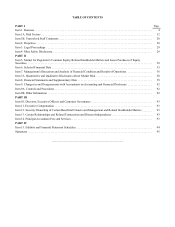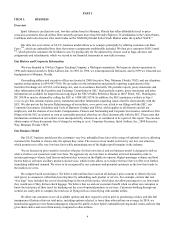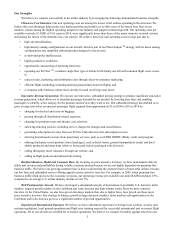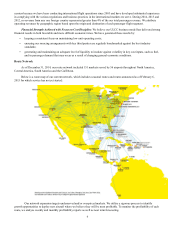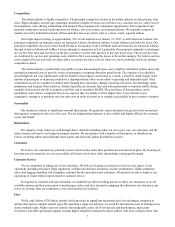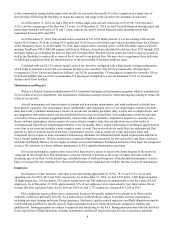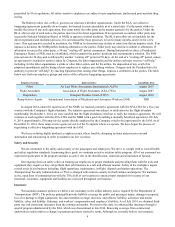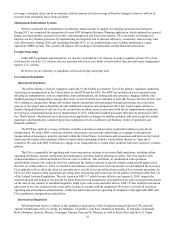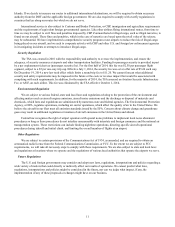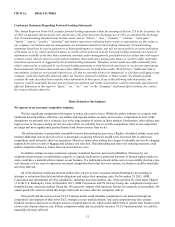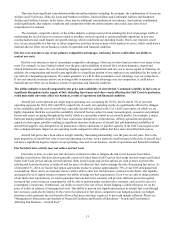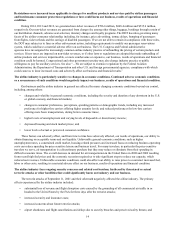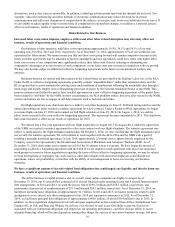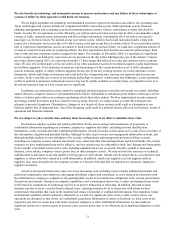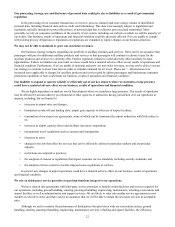Spirit Airlines 2014 Annual Report Download - page 13
Download and view the complete annual report
Please find page 13 of the 2014 Spirit Airlines annual report below. You can navigate through the pages in the report by either clicking on the pages listed below, or by using the keyword search tool below to find specific information within the annual report.13
There has been significant consolidation within the airline industry including, for example, the combinations of American
Airlines and US Airways, Delta Air Lines and Northwest Airlines, United Airlines and Continental Airlines and Southwest
Airlines and AirTran Airways. In the future, there may be additional consolidation in our industry. Any business combination
could significantly alter industry conditions and competition within the airline industry and could cause fares of our
competitors to be reduced.
The extremely competitive nature of the airline industry could prevent us from attaining the level of passenger traffic or
maintaining the level of fares or revenues related to ancillary services required to sustain profitable operations in new and
existing markets and could impede our growth strategy, which could harm our operating results. Due to our relatively small
size, we are susceptible to a fare war or other competitive activities in one or more of the markets we serve, which could have a
material adverse effect on our business, results of operations and financial condition.
Our low cost structure is one of our primary competitive advantages, and many factors could affect our ability to
control our costs.
Our low cost structure is one of our primary competitive advantages. However, we have limited control over many of our
costs. For example, we have limited control over the price and availability of aircraft fuel, aviation insurance, airport and
related infrastructure taxes, the cost of meeting changing regulatory requirements and our cost to access capital or financing. In
addition, the compensation and benefit costs applicable to a significant portion of our employees are established by the terms of
our collective bargaining agreements. We cannot guarantee we will be able to maintain a cost advantage over our competitors.
If our cost structure increases and we are no longer able to maintain a cost advantage over our competitors, it could have a
material adverse effect on our business, results of operations and financial condition.
The airline industry is heavily impacted by the price and availability of aircraft fuel. Continued volatility in fuel costs or
significant disruptions in the supply of fuel, including hurricanes and other events affecting the Gulf Coast in particular,
could materially adversely affect our business, results of operations and financial condition.
Aircraft fuel costs represent our single largest operating cost, accounting for 38.9%, 40.2% and 41.2% of our total
operating expenses for 2014, 2013 and 2012, respectively. As such, our operating results are significantly affected by changes
in the availability and the cost of aircraft fuel, especially aircraft fuel refined in the U.S. Gulf Coast region, on which we are
highly dependent. Both the cost and the availability of aircraft fuel are subject to many meteorological, economic and political
factors and events occurring throughout the world, which we can neither control nor accurately predict. For example, a major
hurricane making landfall along the Gulf Coast could cause disruption to oil production, refinery operations and pipeline
capacity in that region, possibly resulting in significant increases in the price of aircraft fuel and diminished availability of
aircraft fuel supplies. Any disruption to oil production, refinery operations, or pipeline capacity in the Gulf Coast region could
have a disproportionate impact on our operating results compared to other airlines that have more diversified fuel sources.
Aircraft fuel prices have been subject to high volatility, fluctuating substantially over the past several years. Due to the
large proportion of aircraft fuel costs in our total operating cost base, even a relatively small increase in the price of aircraft fuel
can have a significant negative impact on our operating costs and on our business, results of operations and financial condition.
Our fuel derivative activity may not reduce our fuel costs.
From time to time, we enter into fuel derivative contracts in order to mitigate the risk to our business from future
volatility in fuel prices. Our derivatives generally consist of United States Gulf Coast jet fuel swaps (jet fuel swaps) and United
States Gulf Coast jet fuel options (jet fuel options). Both jet fuel swaps and jet fuel options are used at times to protect the
refining risk between the price of crude oil and the price of refined jet fuel, and to manage the risk of increasing fuel prices. As
of December 31, 2014, we had jet fuel option agreements in place to protect approximately 35% of our 2015 anticipated fuel
consumption. There can be no assurance that we will be able to enter into fuel derivative contracts in the future. Our liquidity
and general level of capital resources impacts our ability to hedge our fuel requirements. Even if we are able to hedge portions
of our future fuel requirements, we cannot guarantee that our derivative contracts will provide sufficient protection against
increased fuel costs or that our counterparties will be able to perform under our derivative contracts, such as in the case of a
counterparty’s insolvency. Furthermore, our ability to react to the cost of fuel, absent hedging, is limited because we set the
price of tickets in advance of incurring fuel costs. Our ability to pass on any significant increases in aircraft fuel costs through
fare increases could also be limited. In the event of a reduction in fuel prices compared to our hedged position, our hedged
positions could counteract the cost benefit of lower fuel prices and may require us to post cash margin collateral. Please see
“Management’s Discussion and Analysis of Financial Condition and Results of Operations—Trends and Uncertainties
Affecting Our Business—Aircraft Fuel.”


